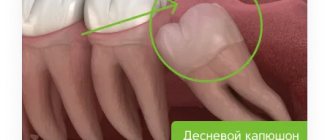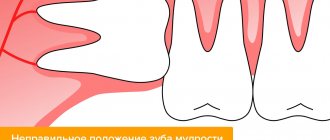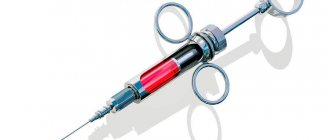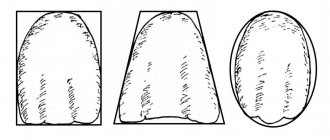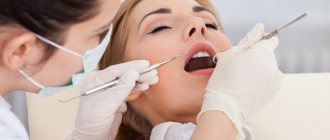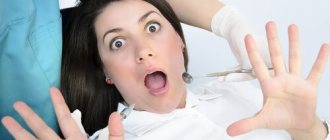The Esthetic Classic Dent clinic employs only experienced surgeons who expertly perform impacted tooth removal of any complexity quickly, efficiently and painlessly. Thanks to the professionalism of our doctors, our patients do not experience complications after such operations, and they tolerate the rehabilitation period easily and without significant discomfort.
Why is an impacted tooth dangerous?
Why doesn't the tooth erupt? Perhaps in childhood the patient had his baby teeth removed too early, which is why the molars initially formed incorrectly. Also, the cause of this phenomenon may be the displacement of neighboring molars in relation to their physiological position.
Impacted teeth can be called a time bomb, since sooner or later they can provoke the following problems:
- Caries;
- Inflammation of the gums around the area of the unerupted tooth;
- Curvature of neighboring teeth due to constant pressure;
- Vomiting sensations, swelling of soft tissues, numbness of the face due to the effect on nerve endings;
- Periodontitis;
- Periodontal disease;
- Bite disorders.
Where to remove and how much does it cost?
Removal of impacted and/or dystopic teeth is the prerogative of highly qualified dental surgeons. The operation is quite complex, and the consequences of inept or thoughtless manipulations can lead to serious consequences, which only maxillofacial surgeons can correct. The main task of the patient is to find a worthy specialist who can be trusted with his health. These are the doctors who work at the “V Put” restorative dentistry clinic. High qualifications and constant improvement of skills are a guarantee of complete, adequate and safe treatment for our clients.
The higher cost of removing an impacted/dystopic tooth (compared to simple removal) is explained by the complexity of the operation. Preliminary prices can be found in the price list; The final cost is announced at a consultation after examination and diagnosis.
Make an appointment at a time convenient for you and receive a treatment plan for free!
Is it necessary to remove an impacted tooth?
A tooth that has not fully erupted or remains under the gum may not make itself felt for a long time. Only x-rays will show that it is positioned incorrectly. But is it worth having surgery if you don’t experience any discomfort? Dentists unequivocally say yes!
Even if the tooth is not causing concern, it continues to grow under the gum and will eventually begin to dislodge its neighbors. With partial teething, hygiene becomes more difficult - it is almost impossible to reach some areas with a brush, which is why bacteria accumulate on them and caries develops. By the way, it is also almost impossible to cure it qualitatively.
Over time, the infection can spread throughout the entire oral cavity and even move higher - to the pharynx and ear canal, causing inflammatory processes in them.
By the way, the sooner an impacted tooth is detected and removed, the easier the operation itself will be. In addition, surgery is always easier to tolerate if there is no acute inflammation at the time. If you find a tooth on an x-ray that is growing incorrectly and is unlikely to ever fully erupt, it is better to immediately contact a surgeon.
Diagnosis of dystopia
An orthodontist or even a dental therapist can easily determine tooth dystopia during a routine examination if the anomaly is not complex. In some cases, when an element of the dentition remains in the gum, ends up in the palate or another place, during the examination one can only suspect a problem.
If the doctor has not found one of the teeth that should have already erupted in a child (or an adult, if we are talking about eights), he will refer the patient for an x-ray examination. The picture clearly shows all the irregularities and you can see the formed teeth in the soft tissues. To clarify the position and for subsequent treatment, arthopantomography, creation of plaster models of the jaws, and teleradiography are used.
How is impacted wisdom tooth removed?
The operation to remove an unerupted “eight” is quite complex and sometimes lasts up to three hours. The smaller the part of the tooth that appears above the surface of the gum, the more time and effort the surgeon will have to spend.
- First of all, the doctor injects anesthesia - without it, manipulation is impossible.
- He then makes an incision into the gum and lifts the flap to gain access to the bone.
- Using a special instrument, the surgeon makes holes in the bone tissue. If the tooth is large enough, it is sawed down and removed piece by piece.
- The doctor places medicine into the resulting hole and stitches the wound.
–>
Features of canine correction with braces
The problem can be solved with or without tooth extraction. Both methods help to obtain the space that is missing, but necessary for the dystopic canine to be returned to its place. The choice of the optimal option depends on the clinical situation.
- If removal is not performed, free space is formed due to the gradual lengthening of the dentition with braces. The doctor must assess in advance how the process will affect the proportions of the face.
- If changes in appearance turn out to be negative (for example, the front teeth deviate noticeably forward), a pair of teeth will have to be removed - usually the first premolars.
There is no need to be afraid of removing completely healthy teeth. This method will be suggested by the doctor only if absolutely necessary - to improve chewing function, balance load distribution and maintain the health of the remaining teeth. Due to the free distribution of tooth roots, in this case a stable correction result that is not prone to relapse will be achieved.
Orthodontic patients often ask: is it possible to put braces on one jaw? Dystopic fangs are just that case. If there is a need for significant straightening of the canines with braces on the upper jaw and minor correction of the lower dentition, the lower bracket can be installed later, which is more financially beneficial for most patients.
Impacted and dystopic teeth
Impacted tooth
- this is a tooth that has already fully formed, but cannot fully erupt, since it is partially or completely covered by either the gums, the jaw bone, or another tooth located nearby. As a result, such a tooth gets stuck in the jaw, the gums become swollen and inflamed, causing severe pain.
This is one of the most common dental anomalies. The most common impacted “wisdom teeth” are the eights in the lower jaw. In fact, this is why wisdom teeth are most often removed. While they are in their rudimentary, “dormant” state, they do not cause pain or discomfort, but if they begin to erupt incorrectly, they can not only provoke inflammation, but also damage other teeth.
In this regard, dentists recommend removing the impacted tooth immediately after it begins to cut, without waiting or delaying. Retention of a wisdom tooth before age 25 is not considered an anomaly.
, but normally after 25 these teeth still erupt. Sometimes they are removed at an early age to prevent them from erupting in the future.
Often, an impacted tooth is also called a dystopic tooth, in which it is displaced inside the gum and grows into the cheek, palate or gum, and not as it should.
Consequences of dystopia
Although dental dystopia does not seem like a terrible disease, it can create many problems. This is why wisdom teeth that have grown incorrectly are most often removed. Among the most unpleasant consequences of the disease:
- disruption of the entire dentition, because due to one incorrect element, the rest move or cannot erupt correctly;
- injury to the tissues of the cheeks, tongue, lips, which can cause ulcers and even provoke the development of tumors;
- complication of oral hygiene, which leads to inflammation, caries, both on the dystopic and adjacent teeth;
- the appearance of gingival pockets where bacteria accumulate, leading to pericoronitis;
- impaired chewing function, which in turn reduces the quality of food and can lead to deterioration of the gastrointestinal tract;
- difficulty pronouncing words, poor diction;
- violation of the facial skeleton, unaesthetic appearance of the lower part of the face.
Almost always, dystopia leads to unpleasant aesthetic consequences, which causes complexes and rejection of one’s appearance in the child, and then in the adult. Of course, this can be worked out with a psychologist, but it is much wiser and more correct to deal with the cause than to deal with the consequences.
Causes of retention and dystopia of teeth
- Hereditary factor;
- Too early loss of baby teeth. If, after the loss of a baby tooth, the molar does not immediately grow in this place, the position of the teeth that have not yet erupted in the jaw may shift, resulting in dystopia. The later a molar erupts, the greater the risk of it becoming dystopic;
- Malocclusions, crowded dentition.
Among baby teeth, dystopic ones are rare, but this problem can arise due to too dense gums, through which it is difficult for weak teeth to break through, as a result of which they grow incorrectly. In its normal state, a child’s gums, before the eruption of baby and molar teeth, become more elastic and easily part, making room for new teeth.
In addition, in the case of childhood retention, it is often not the wisdom teeth that fail to erupt (as in most adults), but the canines and small molars, which grow later than all the others. This is not only a rather painful process, but also potential problems with the correct bite of the teeth.
On a note!
The evolutionary version explains tooth retention by the fact that after a long period of time, our jaw has significantly decreased and lost capacity, which now creates an obstacle to the eruption of wisdom teeth and, as a result, leads to dental dystopia.
Symptoms of dystopia
Symptoms of dental dystopia are most often visual and easily noticeable. It is enough to look at the position of all the elements of the dentition to see that some of them are in the wrong places or are simply growing unevenly. Other symptoms:
- there is no tooth in the bite, and the period of eruption has already passed;
- inflammation and pain are felt at the site of the wisdom tooth;
- The wisdom tooth did not appear on time
It is interesting that in a number of cases there is no wisdom tooth at all - it does not form and does not erupt. Dentists call this option a variation of the norm.
Types of Impacted Teeth
The position of an unerupted tooth inside the gum varies, and depending on how it is located there, the doctor decides whether to remove the tooth or relieve inflammation and allow the tooth to erupt.
Degree of retention:
- Complete (the tooth is completely hidden by the gum and bone, it cannot be seen or felt. Most often this refers to impacted wisdom teeth);
- Partial (a small part of the crown is visible, the rest is hidden);
- Retention in hard tissues (bones);
- Retention in soft tissues (gums).
Inclination of impacted tooth and crown:
- Mesial (the tooth is slightly tilted forward - this is the type of retention that most often occurs);
- Vertical (the tooth grows correctly, but cannot erupt due to lack of space);
- Horizontal (the tooth lies completely inside the gum or bone with the tip facing the other teeth);
- Distal (tooth tilted back).
In addition, although quite rare, retention occurs not of one tooth, but of several adjacent teeth of the same type (for example, two molars). This problem most often occurs in children.
Conclusions. Expert advice
Dystopia is the incorrect position of a tooth in the jaw: its displacement forward or backward, down or up, as well as rotation around its axis or tilt. The appearance of such an anomaly is associated both with hereditary factors and with bad habits or mechanical damage to the jaw. The sooner dystopia is detected, the easier it is to cure. In adults, the wisdom tooth most often found to be dystopic is the third molar, because there may simply not be enough space in the jaw for it to erupt.
The consequences of such anomalies include general malocclusion, frequent inflammatory diseases, impaired chewing function, and much more. Depending on the complexity of the case, dystopia is treated either by tooth extraction or with the help of braces. If the decision is made to remove it, it is important to carry out the operation carefully and correctly. If treatment is started on time, the prognosis for the disease is positive.
How to identify an impacted tooth?
The most difficult thing to determine is retention when something simply hurts, and what exactly is unclear. Especially if it is an impacted tooth in a child, it is more difficult for the child to realize and tell about it. However, it can be quite difficult for an adult to understand that the problem is an impacted wisdom tooth, especially if you have never had to deal with this before.
Symptoms of an impacted tooth:
- Swelling, redness and painful swelling of the gums around it;
- The crown of a half-erupted impacted tooth may be partially visible, or the tubercle if it is completely hidden by the gum;
- Neighboring teeth may move forward slightly, become mobile, and ache, as if something is pressing on them from the impacted tooth;
- The pain intensifies when moving the jaw, opening the mouth, or eating. On the side where the tooth cannot erupt, it may be impossible to chew at all;
- In the worst cases, when an impacted tooth remains asymptomatic for a long time, a cyst may form with complications - the patient’s general health worsens, and the temperature may rise.
Diagnosis of an impacted tooth is carried out in the clinic, through an orthopantomogram of the jaw
or x-ray. It is necessary to determine where exactly the impacted tooth is located, how deeply it is hidden, and whether it has the opportunity to erupt.
The decision to remove an impacted tooth is made individually in each specific case. If there are no complaints, the tooth is located correctly in the jaw, then it may well erupt and perform its function in the future. However, due to pain and possible complications (loose roots of adjacent teeth, inflammation, displacement of teeth), a decision is most often made to remove such a tooth.
Forecast of dystopia
The appearance of a dystopic tooth in a child is not such a serious problem (especially if there is only one). Before a person’s facial skeleton stops growing, the position of the main teeth can be normalized quite quickly. Therefore, it is recommended to begin treatment immediately after identifying the problem. In this case, all the teeth will most likely fall into place and in the future, in adulthood, will no longer cause concern.
If correction of dystopia in an adult is required, this almost always causes many difficulties. After 18-20 years, teeth are no longer so mobile, so correcting their position requires many preparatory interventions. It is much easier to remove a problematic tooth than to try to put it back in place.
Being cured in a timely manner, dystopia has virtually no negative impact on a person’s future life. Most often, the correct bite is maintained for a long time and does not require supervision by a doctor.
Prices for surgical services at the clinic
| Service | Price |
| Tooth extraction | |
| Removal of a tooth | RUB 3,900 |
| Removal of a tooth of III degree of mobility | 2,000 rub. |
| Wisdom tooth removal | 5,500 rub. |
| Simple tooth extraction | RUB 3,900 |
| Surgery to remove an impacted tooth | 7,500 rub. |
| Other | |
| Bone grafting | 25,000 rub. |
| Sinus lift closed | RUB 18,900 |
| Open sinus lift | 26,500 rub. |
| Excision of the tooth hood | 2,800 rub. |
| Resection of a single-root tooth | 9,500 rub. |
| Resection of a multi-rooted tooth | 7,000 rub. |
| Alveolar ridge correction | RUB 5,900 |
| Opening a periodontal abscess | RUB 3,800 |
| Lip frenuloplasty | 5,500 rub. |
| Plastic frenulum of the tongue | RUB 5,900 |
| Socket curettage | 800 rub. |
| Treatment of alveolitis | 2,500 rub. |
| Dental implantation | |
| Adin implant installation | RUB 21,500 |
| OSSTEM implant installation | RUB 26,700 |
| Installation of the Nobel Replace Select implant | 40,000 rub. |
| Ankylos implant installation | 41,000 rub. |
| Installation of Hi-Tech implant | RUB 29,500 |
| Implant installation Mis | 32,000 rub. |
Removing an impacted (unerupted) wisdom tooth is a complex operation that is performed by an experienced dental surgeon with mandatory anesthesia.
Sign up Duration 15-60 minutes Cost from 840 rub. All prices
One of the common pathologies in dentistry is an impacted tooth. An impacted tooth is a tooth that, for some reason, cannot erupt on its own and take its place in the dentition. Removal of an impacted tooth is the most likely outcome of having such a tooth in the oral cavity. Very often, upper or lower “wisdom teeth” or, as they are also called, “eight teeth,” grow in this way.
Removing an impacted wisdom tooth is a rather complex operation that is performed only by an experienced dental surgeon with mandatory anesthesia. An impacted wisdom tooth can cause malocclusion, serious misalignment of teeth in a row, and can also negate efforts to straighten and correct teeth. Additionally, if this tooth becomes infected, it can become a source of infection for other teeth and lead to serious problems. Removal of an impacted tooth is carried out in EXPERT dentistry painlessly and without complications for patients!
Reasons for violation
Why is dystopia being formed? Factors that usually lead to this pathology are:
- genetic;
- embryonic;
- exogenous.
Often such violations occur due to improper formation of tooth germs at the embryonic stage. It has been noted that dystopia often occurs with the following dental anomalies:
- supernumerary teeth;
- macrodentia;
- imbalances in dental size (primary and permanent);
- partial adentia (lack of teeth);
- violation of deadlines or “confused” order of dental eruption;
- early removal of baby teeth.
Sometimes people receive a parental “legacy” in the form of a set of large teeth and a small jaw. In this case, the teeth often become deformed and become dystopic.
However, such dental pathologies are not always caused by internal or congenital causes. Often this condition is facilitated by the following external factors:
- mechanical injuries of the jaw (dislocation, bruise, etc.);
- cicatricial disorders of the oral mucosa;
- bad (usually childhood) habits (thumb sucking, prolonged use of a pacifier, pencil biting).
Indications for removal of an impacted tooth
Removing impacted eights is a serious surgical procedure. The more complex the operation, the longer it takes, and the more severe the anesthesia must be. Indications for removal of impacted teeth include the following factors:
- an impacted tooth interferes with the correct placement of other teeth in the dentition
- after orthodontic treatment to correct the bite, since an impacted tooth can disrupt an already corrected bite
- the appearance of a cyst. In this case, it is necessary not only to remove the impacted tooth, but also the cyst. To remove a cyst, it is often necessary to remove the pulp from an adjacent healthy tooth.
- if the impacted tooth is in close contact with the adjacent tooth
- during the formation of a gingival hood
- the development of an inflammatory process around the impacted tooth, which can lead to an abscess.
How to normalize the position of dystopic fangs?
When choosing a technique, the orthodontist takes into account the severity and type of pathology, as well as the age of the patient. For children under 12 years of age, the use of specialized removable and non-removable structures is recommended:
- night guards worn at night;
- easy-to-maintain soft dental plates designed for long-term wear;
- trainers that target dentofacial defects.
The sooner the correction begins, the faster it will be possible to straighten teeth that are not yet fully formed. On average, the process takes 4–6 months.
Adolescents and adult patients need treatment with braces, which in severe cases will have to be worn for about two years.
Stages of removing an impacted tooth
The difficulty of removing an impacted tooth is determined by the degree of its location and immersion (a distinction is made between bone immersion, in which the tooth has not even emerged from the jawbone, and tissue immersion, in which the tooth is located in the gum, but has not erupted outward). Upper impacted teeth are much easier to remove than lower teeth due to their physiological characteristics.
Removal of an impacted lower tooth is carried out in several stages:
- diagnostics. X-rays are taken to determine the degree of immersion of the tooth, the number of its roots and their location relative to each other and the roots of neighboring teeth.
- anesthesia. We use high-quality drugs and syringes with thin needles for local anesthesia
- removal of an impacted tooth. To do this, the dental surgeon, using special tools and equipment, opens the gum and, if necessary, the jaw, extracts the entire tooth or splits it into several parts and removes them one by one. Be sure to put a medicine into the resulting hole that relieves inflammation. If a large hole forms, sutures may be placed
- A repeat x-ray taken to ensure that all parts of the tooth have been removed.
Recommendations after removal
Removing an impacted wisdom tooth is a complex dental operation, so certain recommendations must be followed after the procedure:
- do not consume food or drink for at least two hours
- Apply ice to the cheek on the removal side during the day.
- do not drink hot drinks or food for the first three days after removal
- do not visit the bathhouse, sauna, reduce physical activity
- do not pick at the hole with sharp objects and do not “lick” it with your tongue
- maintain oral hygiene, brush your teeth carefully
- If your doctor has prescribed medications, you should definitely take them
- rinse your mouth after eating with boiled water
- try to chew with the opposite side of the jaw.
Cost of removing an impacted tooth in St. Petersburg:
An impacted tooth is quite difficult to remove. This is a full-fledged dental operation, which is performed under serious anesthesia and only by an experienced dental surgeon. For the removal of an impacted tooth, the price depends on many factors - the complexity of the removal, the determined depth of immersion and location of the impacted tooth, the chosen anesthesia, the time of the operation, etc.
Removal cost
| Local injection anesthesia (as a separate service) | 840 ₽ |
| Removal of a tooth (roots) with preliminary dissection of the soft tissues around the tooth (roots) | 4 400 ₽ |
| Removal of an impacted tooth with preliminary dissection of the surrounding soft and hard tissues | 6 300 ₽ |
| Removal of an impacted tooth | 4 210 ₽ |
| Surgical exposure of an impacted tooth | 1 540 ₽ |
Prevention of dystopia
Dentists are confident that if you carefully monitor your child’s dental health from early childhood, you can avoid most bite problems. Dystopic teeth are no exception, because their appearance is not always associated with hereditary factors. To prevent dystopia, doctors recommend the following:
- proper nutrition, adherence to the daily routine of a pregnant mother;
- prevention of jaw injuries from an early age;
- regular visits to the dentist, wearing devices to correct malocclusion;
- giving up bad habits (including weaning off the pacifier after a year and from thumb sucking in sleep), etc.
If you and your child regularly visit a dentist, he will give recommendations on what exactly to do in your case.
In what cases is dental surgery difficult?
Complex manipulations regarding tooth extraction include the following situations:
- with disconnected roots that are excessively curved inward or directed in different directions;
- when the problem tooth is located in the affected bone;
- in the complete absence of a crown, when there is nothing to grab onto with forceps;
- if a filling was previously installed in the tooth, which can crack under the mechanical influence of forceps;
- when the tooth is impacted or dystopic;
- removing the "eight"
These are the main clinical features in which it is impossible to get rid of a diseased tooth using a standard simple procedure. Moreover, in each specific case the reasons for complex extraction may be individual.

